In theaters today, DreamWorks Animation’s latest feature The Croods goes back to the basics with a strong family comedy set in a magical, prehistoric period.
The world will be watching DreamWorks’ caveman family very closely this spring. Fortunately, The Croods, the studio’s first venture after the disappointing box-office performance of the holiday 2012 release Rise of the Guardians, has been generating a healthy early buzz, thanks to its striking visuals and an easy-going script which doesn’t try to bend any rules or re-invent the medium. As the film’s co-directors and co-writers Chris Sanders and Kirk De Micco tell us, they have been too busy fine-tuning every detail and nuance to worry about outside pressure or industry expectations.
De Micco’s ties with the project go back all the way to 2004 when he co-wrote the script with Monty Python alum John Cleese. Originally titled Crude Awakening, the pic was tailored for then-DreamWorks partner Aardman Animations and centered on the conflicts between two clashing caveman clans. After Aardman broke away from DreamWorks and started a relationship with Sony Animation, De Micco (Space Chimps, Racing Stripes) and Sanders (Lilo & Stitch, How to Train Your Dragon) were tapped to reshape the film and take it in a different direction.
“It was a different story, but it focused on a similar theme—the fear of change,” recalls De Micco. “Jeffrey [Katzenberg] believed in the project even after Aardman went to Sony, and when Chris joined DreamWorks, he was very intrigued with the story. I was very lucky that he wanted to be involved with the project. Then in 2008, he went to work on How to Train Your Dragon and I stayed behind and worked on the film until he returned to the project three years ago.”
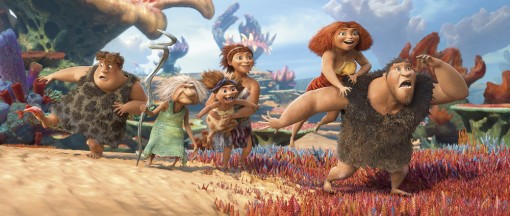
Both Sanders and De Micco felt that something needed to be done with the original premise of the film, which was more of a buddy road picture.
“It just never took off,” says Di Micco. “I told Chris, what if we strip away the whole village and make the film about the family? We wanted the father to be in the back seat and keep his family together, all the time, watching his daughter—the thing he loves the most—change before his very eyes. It’s funny, but taking away the village allowed us to spend more time with the family. It’s the first DreamWorks movie about a real family. It just felt fresh and unique.”
Sanders agrees.
“It had a lot of great elements and nice characters, but it just wasn’t lifting off the ground. One day Kirk called me and said, ‘The story should be about one caveman family. They lose their home and have to go look for another home, and on this journey, they change.’ I said, ‘Congratulations, you’ve made it work!’ That’s what you have to do when something is not working. You have to step back and take a very critical look at it and do something radical. The moment Kirk came up with that, the movie was airborne.”
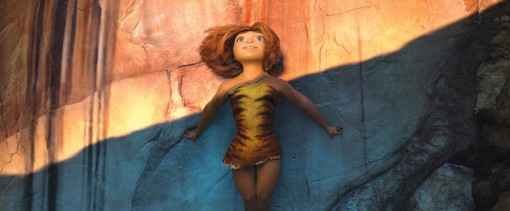
Exploring new narrative territories, the filmmakers decided to focus more on the family dynamics instead of traditional villains as is common in the usual animated stories.
“The arc of the movie is happening inside the characters,” explains Sanders. “I’d never worked on a story that was as linear as this one. The storyline begins at point A and goes to B, and along the way, it’s the characters that are the elements that are changing. This movie was storyboarded more than any other picture I’d worked on. We wrote, rewrote and discarded so many sequences—I think there were dozens of drafts of the script, and each would be noticeably different from the previous ones.”
Another interesting aspect of the movie is its wide range of tones. As De Micco explains, the adventure begins in a pretty broad place. The caveman family are depicted as child-like characters with an innocent take on life.
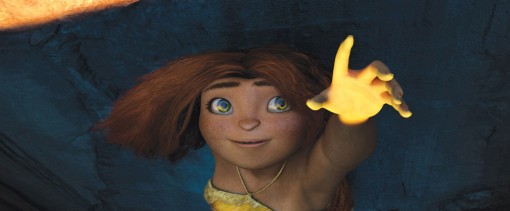
“They have their hearts in the right place and they’re very lovable,” says De Micco. “Over the course of the film, the tone changes a bit. In the third act, we are exploring issues like why are we here and what’s the point of family. Once you strip humans of society and modern technologies, these are the basic elements that are really important. You start out in a broad place, and then you shift gear and go to place where the story has real heart and emotion.”
Fortunately, the film had a secret weapon to help it make these transitions—the music of Oscar-nominated composer Alan Silvestri, whose long list of credits includes both animated pics such as The Polar Express and Lilo & Stitch and live-action favorites like The Avengers and Forrest Gump.
“He’s been there for us for a few years,” says De Micco. “His music really helps make the transitions from comedy to drama run smoothly.”
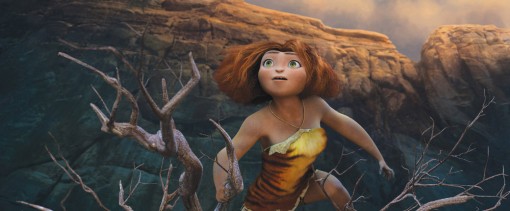
Evolutionary Ideas
Once it was decided that the film would be set in a “yet-to-be-discovered” prehistoric era known as the Croodaceous Period, the art and production design team looked for inspiration in real life locations such as Utah’s Zion National Park and slide shows about the strange shapes and animals found on Earth.
“We were looking for anything and everything that could be a fresh and awesome environment,” recalls Sanders. “The goal was that no matter what you see in The Croods, there’s a co-relation with something on earth.”
The film’s vague time period allowed the creative team’s imagination to go wild, leading to the introduction of wild hybrid animals. After all, who doesn’t love sea-turtle-parrots, piranha-birds or owl-bears? The key was to keep the elements of believability in every creature.
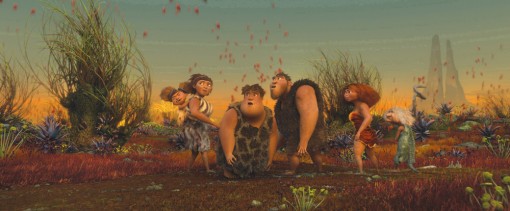
“Things are pushed and caricatured, but they echo the real world. Let’s say if a creature or a tree has a fantastical shape, then it will have a grounded surfacing, or vice-versa. Our character designer Shane Prigmore created some wonderful, mash-up creatures—we call them evolutionary dead-ends, slip creatures that didn’t quite make it. Then, they were brought to 3D life by Takao Noguchi, and he put so much appeal into all of these characters.”
Brushing aside all comparisons with that other prehistoric family The Flintstones, De Micco says the goal was to create an animated world that would be believable and fresh.
“We wanted the film to do for cavemen what the movie 28 Days Later did for zombies!” he says, recalling the much-admired 2002 Danny Boyle movie. “The whole approach is set up in the opening hunting sequence,” he explains. “We see them running 70 miles an hour. The animators brought such fluidity and athleticism to that scene. The characters don’t move like the cavemen from Quest for Fire. They really move like various animals.”
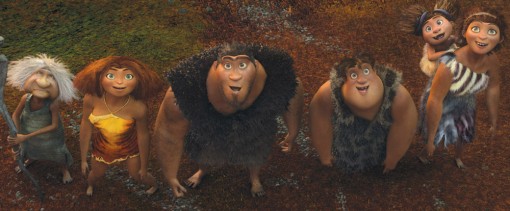
De Micco says he is quite proud of the way the different elements of the film—the design, the vfx, the 3-D technology, the animation, the music, the voices—came together to tell an epic tale.
“Some of the things I love about the film are the more subtle features,” he says, “For example, I love the fact that the 3-D is very atmospheric…it’s not gimmicky—the dust floating around, the bugs flying around the screen, explosions going off in the distance. There’s a sequence where the characters are sinking in tar pits. I think it’s interesting because we used a cloth simulator instead of a liquid simulator to depict the tar. I think they really killed it and it’s quite special: You can see every bubble and it really feels like they’re sinking in the tar.”
Ask Sanders what his favorite scene in the movie is and he is quick to mention the opening hunting sequence. The animators pay homage to the 1984 Eddie Murphy blockbuster Beverly Hills Cop, in which the lead character is tossed around in the back of a runaway cigarette truck. In the prehistoric world, our characters are stuck to the back of an out-of-control, giant mammoth.
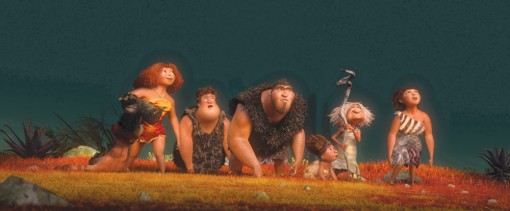
“We pulled from the staging of that movie, and it really worked for us. It’s a very fun and broad sequence, and it was difficult to pull off. But I knew it was really working when the scene got a great response when we screened the movie at the Berlin Film Festival earlier this year.”
The director also got to incorporate an idea he had in mind back when he was working on American Dog for Disney in 2005 (a project that eventually became Bolt, after Sanders left Disney and found a new home at DreamWorks).
“It’s not exactly the same scene I had in mind for American Dog, but it’s the same premise,” he shares. “For the Croods, going out at night is a death sentence. They live and hunt during the day—so in the movie, the scene when they see the night sky for the first time, that is an overwhelming, emotional moment for them, and it’s a turning point for us.”
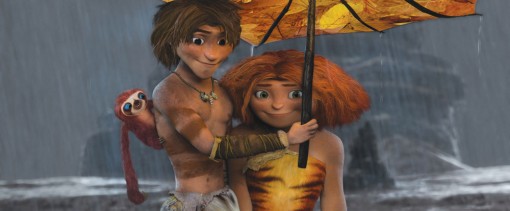
Now that the fruit of their labor is finally in theaters and being seen by moviegoers all over the world, Sanders and De Micco are finally ready to kick back and reap the rewards of many years of hard work.
“I’ve really enjoyed working in an environment where everyone is willing to do anything and everything to make the story work,” says Sanders. “Our animated movies are monumentally complex creations—they’re like modern cathedrals. We have computers working in every realm, but they’re really hand-made—the results of many, many hours of amazing work by the designers, art department, animators, vfx teams, surfacing department, character effects, matte painters—they are all our secret weapons.”
20th Century Fox presents DreamWorks Animation’s The Croods in 3-D and standard theaters nationwide today.
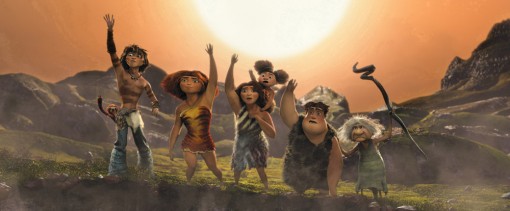




 Win a Funko X Lilo & Stitch Prize Pack!
Win a Funko X Lilo & Stitch Prize Pack! 
